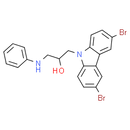Description
P7C3 is a novel and potent pro-neurogenic, neuro-protective small molecule, orally available and brain penetrant, discovered from an in vivo screening in mice. It can protect newborn neurons in the dentate gyrus and stimulates the growth of new neurons. It can also enhance learning and memory in aged rats. P7C3 can preserve axonal integrity after injury, before neuronal cell death occurs, in a rodent model of blast-mediated traumatic brain injury (TBI). MOA study showed P7C3 could bind nicotinamide phosphoribosyltransferase (NAMPT), the rate-limiting enzyme involved in the conversion of nicotinamide into nicotinamide adenine dinucleotide (NAD). Administration of active P7C3 chemicals to cells treated with doxorubicin, which induces NAD depletion, led to a rebound in intracellular levels of NAD and concomitant protection from doxorubicin-mediated toxicity.
Product information
CAS Number: 301353-96-8
Molecular Weight: 474.19
Formula: C21H18Br2N2O
Chemical Name: 1-(3,6-dibromo-9H-carbazol-9-yl)-3-(phenylamino)propan-2-ol
Smiles: OC(CNC1C=CC=CC=1)CN1C2=CC=C(Br)C=C2C2=CC(Br)=CC=C12
InChiKey: FZHHRERIIVOATI-UHFFFAOYSA-N
InChi: InChI=1S/C21H18Br2N2O/c22-14-6-8-20-18(10-14)19-11-15(23)7-9-21(19)25(20)13-17(26)12-24-16-4-2-1-3-5-16/h1-11,17,24,26H,12-13H2
Technical Data
Appearance: Solid Power.
Purity: ≥98% (or refer to the Certificate of Analysis)
Solubility: DMSO up to 100 mM
Shipping Condition: Shipped under ambient temperature as non-hazardous chemical or refer to Certificate of Analysis
Storage Condition: Dry, dark and -20 oC for 1 year or refer to the Certificate of Analysis.
Shelf Life: ≥12 months if stored properly.
Stock Solution Storage: 0 - 4 oC for 1 month or refer to the Certificate of Analysis.
Drug Formulation: To be determined.
HS Tariff Code: 382200
How to use
In Vivo:
P7C3 was orally administrated to mice at 5-10 mg/kg once per day. It displays favorable distribution into the brain (AUC brain/AUC plasma ratio of 3.7 for oral delivery).
References:
- Pieper AA, et al. Discovery of a proneurogenic, neuroprotective chemical. (2010) Cell 142(1), 39-51.
- Saxe JP. Screening: Your brain on drugs. (2010) Nat Chem Biol. 6(9):639-40
- MacMillan KS, et al. Development of Proneurogenic, Neuroprotective Small Molecules. (2011) Journal of the American Chemical Society, 133(5), 1428-1437.
- De Jesús-Cortés H, et al. Neuroprotective efficacy of aminopropyl carbazoles in a mouse model of Parkinson disease. (2012) Proc Natl Acad Sci USA. 109(42):17010-5.
- Wang G, et al. P7C3 Neuroprotective Chemicals Function by Activating the Rate-Limiting Enzyme in NAD Salvage. (2014) Cell. 158(6):1324-34.
- Yin TC, et al. P7C3 Neuroprotective Chemicals Block Axonal Degeneration and Preserve Function after Traumatic Brain Injury. (2014) Cell Rep. 8(6):1731-40.
Products are for research use only. Not for human use.
Documents
Payment & Security
Your payment information is processed securely. We do not store credit card details nor have access to your credit card information.


